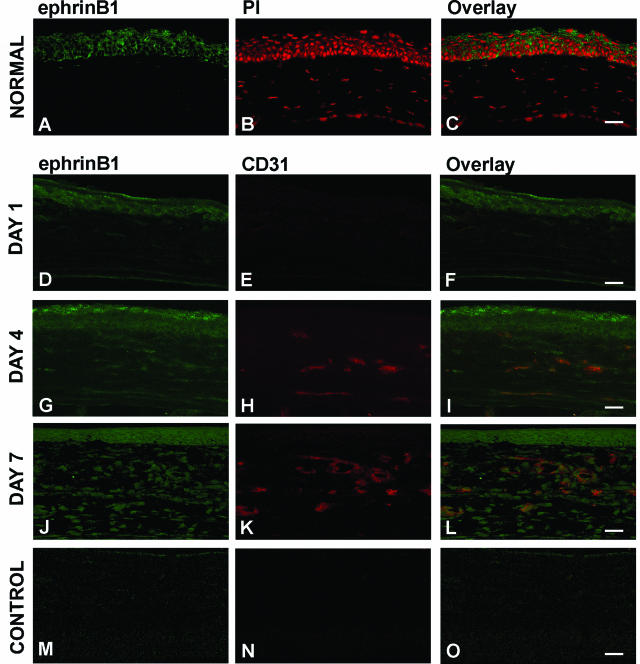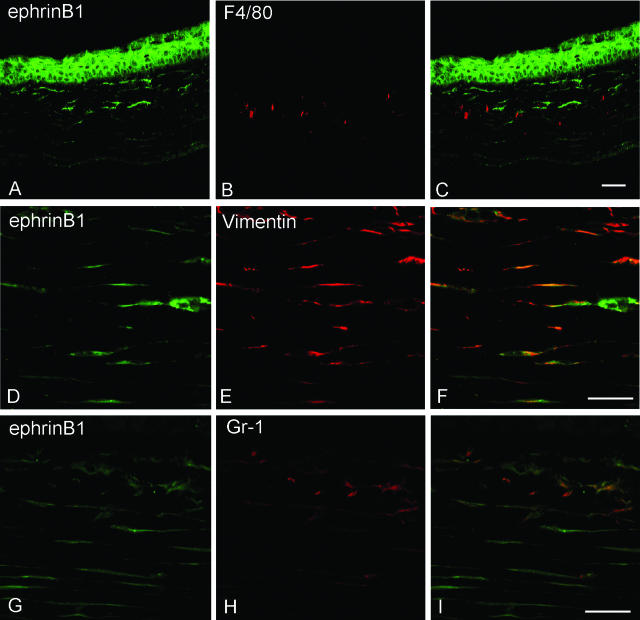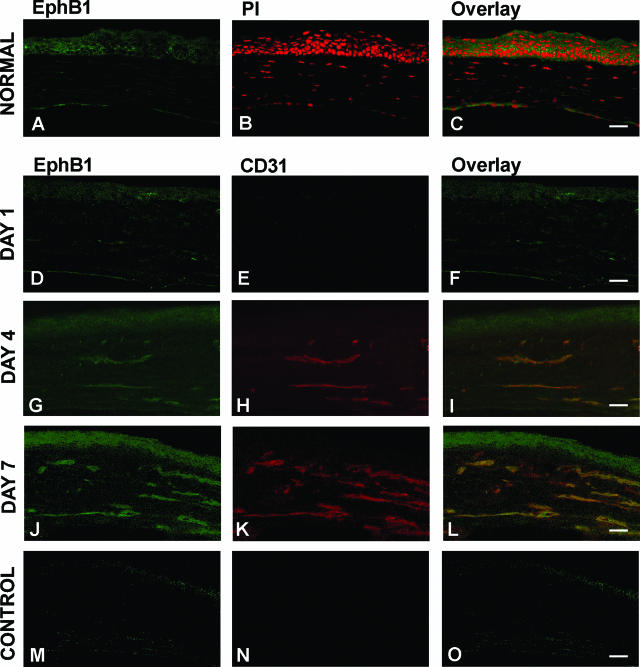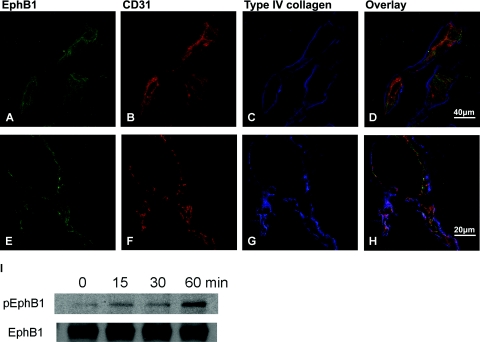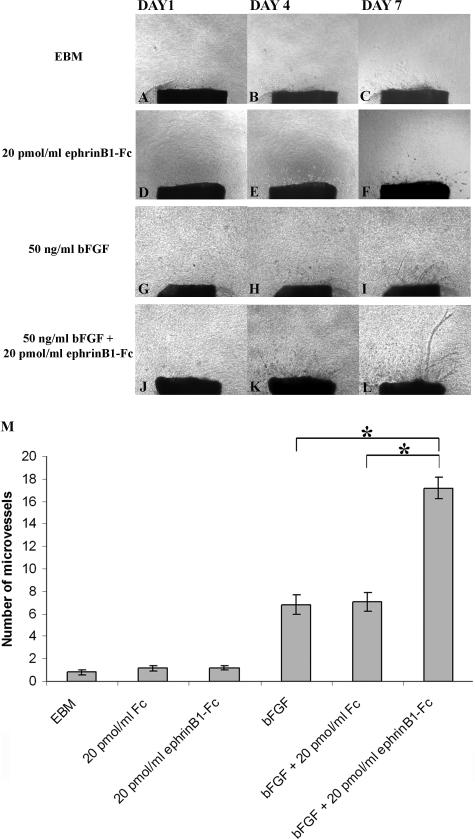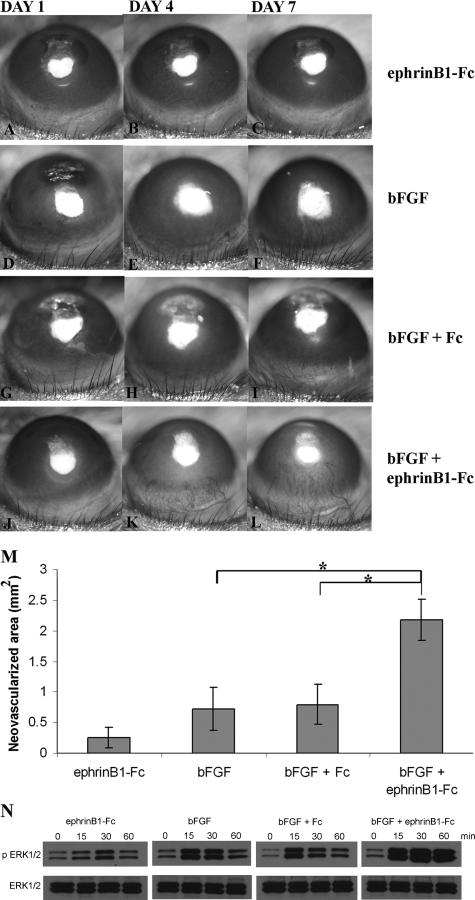Abstract
Corneal neovascularization is a vision-threatening condition caused by various ocular pathological conditions. The aim of this study was to evaluate the function of the ephrin ligands and Eph receptors in vitro and in vivo in corneal angiogenesis in a mouse model. The Eph tyrosine kinase receptors and their ligands, ephrins, are expressed on the cell surface. The functions of Eph and ephrins have been shown to regulate axonal guidance, segmentation, cell migration, and angiogenesis. Understanding the roles of Eph and ephrin in corneal angiogenesis may provide a therapeutic intervention for the treatment of angiogenesis-related disorders. Immunohistochemical studies demonstrated that ephrinB1 and EphB1 were expressed in basic fibroblast growth factor (bFGF)-induced vascularized corneas. EphB1 was specifically colocalized with vascular endothelial marker CD31 surrounded by type IV collagen. EphrinB1 was expressed in corneal-resident keratocytes and neutrophils. Recombinant ephrinB1-Fc, which induces EphB receptor activation, enhanced bFGF-induced tube formation in an in vitro aortic ring assay and promoted bFGF-induced corneal angiogenesis in vivo in a corneal pocket assay. Synergistically enhanced and sustained activation of extracellular signal-regulated kinase was noted in vascular endothelial cell lines after stimulation with ephrin B1 and bFGF combinations. These results suggest that ephrinB1 plays a synergistic role in corneal neovascularization.
Angiogenesis, the formation of new vessels from pre-existing vasculature, is a complex process involving endothelial cell proliferation, migration, and assembly, as well as recruitment of perivascular cells and extracellular matrix remodeling.1–3 Recent studies have identified several endothelial cell receptor tyrosine kinases and their corresponding ligands that mediate angiogenesis. These are the fibroblast growth factor (bFGF)/bFGF receptor, the vascular endothelial growth factor (VEGF)/VEGF receptor, angiopoietin/Tie2, and the ephrin/Eph receptors.4–6
Receptor tyrosine kinases and their ligands play an important role in the regulation of proliferation, cellular survival, and differentiation.7,8 The ephrin receptors are known as one of the largest tyrosine kinase families and are activated by cell-cell interactions. The Eph/ephrin family consists of at least 14 receptors and 8 ligands.9,10 The members of this family are subdivided into class A and class B, based on structure and ligand-binding characteristics of their receptors.10 In general, EphA receptors bind to glycosylphosphatidylinositol anchored ephrinA ligands, and EphB receptors bind to ephrinB ligands containing transmembrane domains.11 Unlike other families of receptor tyrosine kinases, which bind to soluble ligands, Eph receptors interact with cell membrane-bound ephrin ligands.12 Moreover, these receptor-ligand interactions activate a bidirectional signaling pathway through both the Eph receptors and ephrin ligands.13 An Eph receptor can behave as a ligand in the same way that an ephrin ligand can behave as a receptor. Ephrin ligand binding to Eph receptor induces Eph receptor “forward signaling” and ephrin receptor “reverse signaling” as well. Eph/ephrin has been shown to regulate several biological functions such as vascular development, tissue-border formation, cell migration, axon guidance, synaptic plasticity, and embryonic development.14
Hepatocellular carcinoma is rich in vessel structure, and the vessel expresses a higher level of ephrinB1. The expression of the ephrinB1 transcript is significantly higher in tumor tissues than in nontumor tissues, and the ephrinB1-overexpressing cells developed tumors more rapidly than controls in vivo.15 The role of Ephs and their ligand ephrins in angiogenesis and oncogenesis are mediated through cell adhesion, morphogenesis, capillary sprouting, and chemoattraction.16–18
The basic fibroblast growth factor (bFGF, bFGF-2) was first identified as a proangiogenic factor. The FGF family consists of 20 members. The signal transductions of bFGF are mediated by structurally related tyrosine kinase receptors, denoted as FGFR-1, -2, -3, and -4. FGF-derived signaling is essential for development and angiogenesis, because FGFR-1or FGFR-2gene disruption leads to embryonic death.19,20 Tumor progression depends on the angiogenesis, and FGF-2 and VEGF levels are elevated in the serum of individuals with various tumors.21 Recent work using the expression of the dominant-negative FGFR-1 established that FGFR-1 is required for the development and maintenance of the vasculature in the embryo.22 bFGF has been used extensively in corneal angiogenesis models and is thought to be a major factor in the induction of corneal angiogenesis.23–25 It has also been shown that the corneal epithelium produces bFGF after injury, whereas uninjured corneas express very low levels of the bFGF.26 bFGF has been localized to the corneal epithelial and endothelial cells, fibroblasts, macrophages,27 and the extracellular matrix.28,29
The cornea is a unique avascular tissue and has a very important function in the optics of the eyes. To maintain refractive function in the cornea, corneal transparency and regularity are essential. Many corneal dysfunctions, such as infection, injury, and autoimmune reactions lead to corneal angiogenesis. Vessel invasion in the cornea induces opacification of cornea and enhances graft rejection in corneal transplantation.
The role of ephrinB1 in corneal angiogenesis is still unclear. In this study, we demonstrate that ephrinB1 was expressed by keratocytes and neutrophils after bFGF-induced corneal vascularization and that EphB1 was colocalized with vascular endothelial cells in cornea. In the absence of pre-existing new vessel, ephrinB1-Fc did not induce angiogenesis. However, ephrinB1-Fc showed a synergistic effect on capillary tube formation in vitro and on corneal angiogenesis in vivo.
Materials and Methods
Animals
All animal studies were conducted in accordance with the Animal Care and Use Committee guidelines of the Massachusetts Eye and Ear Infirmary and the Association for Research in Vision and Ophthalmology Statement for the Use of Animals in Ophthalmic and Vision Research. C57BL6 wild-type mice, 6 to 10 weeks of age, were used.
Vascular Endothelial Cell Line
Calf pulmonary artery endothelial (CPAE) cells were purchased from the VEC Technologies, Inc. (Rensselaer, NY). CPAE cells were cultured in a microvascular growth medium [endothelial basal medium (EBM-2) with supplement; Cambrex Bio Science, East Rutherford, NJ], which contained 2% fetal bovine serum and incubated at 37°C under 5% CO2.
Confocal Immunohistochemistry
Confocal immunohistochemistry was performed as described previously.30 Cryosections (8 μm) from mouse corneas were fixed in paraformaldehyde for 5 minutes. After blocking with 1% bovine serum albumin in phosphate-buffered saline, sections were incubated for 1 hour to overnight with primary antibodies. After washing with phosphate-buffered saline, the sections were incubated for 30 minutes with secondary antibodies and observed using a confocal microscope (TCS 4D; Leica, Heidelberg, Germany). Primary antibody omission was used initially as a negative control, and it was further confirmed using antibodies preincubated (overnight at 4°C) with their specific blocking antigenic peptides.
The pellet containing 120 ng of bFGF was implanted into the mouse corneas, after which the eyes were collected on days 1, 4, and 7. The specimens were immunostained with the following primary antibodies: rabbit anti-ephrinB1 antibody (Santa Cruz Biotechnology, Santa Cruz, CA), goat anti-EphB1 antibody (Santa Cruz Biotechnology), rabbit anti-type IV collagen antibody (Biogenesis, Poole, UK), and rat anti-CD31 antibody (Pharmingen, San Diego, CA). To detect which cells expressed ephrinB1 in cornea, we used goat anti-vimentin antibody (Santa Cruz Biotechnology), rat anti-F4/80 antibody (AbD Serotec, Raleigh, NC), and anti-Gr-1 antibody (BD Biosciences, San Jose, CA). The secondary antibodies used were fluorescein isothiocyanate-conjugated anti-rabbit IgG antibody (Jackson Immunoresearch Laboratories, West Grove, PA), fluorescein isothiocyanate-conjugated anti-goat IgG antibody (Jackson Immunoresearch Laboratories), rhodamine-conjugated anti-rabbit IgG antibody (Jackson Immunoresearch Laboratories), and Cy5-conjugated anti-rat IgG antibody (Jackson Immunoresearch Laboratories). Propidium iodide (Vector Laboratories, Burlingame, CA) was used for nuclear staining.
Aortic Ring Assay
Aortic ring assays were performed as described by Nicosia and colleagues.31,32 In brief, aortas were obtained from wild-type mice. Fatty tissues around the aorta were carefully removed under a surgical microscope. One-millimeter-long aortic rings were cut and rinsed in five consecutive washes of EBM (Cambrex, Walkersville, MD). Forty-eight-well plates were coated with 150 μl of rat tail type I collagen (BD, Bedford, MA). After gelling at 37°C for 30 minutes, an aortic ring was placed on its side on top of the gel and sealed in place with an overlay of 100 μl of the same collagen. After gelling at 37°C for 1 hour, 300 μl of culture medium (EBM) containing 20 pmol/ml ephrinB1-Fc or 50 ng/ml bFGF (R&D Systems, Minneapolis, MN) with or without ephrinB1-Fc (20 pmol/ml) was added to each well. EphrinB1-Fc was clustered by preincubation with goat anti-Fc antibody (Jackson Immunoresearch Laboratories) at a ratio of 1:2 (molar ratio). On days 1, 4, and 7, the gels were photographed with a phase contrast microscope equipped with a digital spot camera (Micro Video Instruments, Avon, MA). The tube formation was analyzed by counting the number of microvessels according to the reported criteria.31 The endothelial nature of the outgrowth was confirmed by immunostaining with CD31 antibody (BD Biosciences Pharmingen).
Corneal Pocket Assay
A mouse corneal micropocket assay was performed as previously described.24,33 The mice were anesthetized by a combined ketamine and xylazine injection. Proparacaine eye drops were used for local anesthesia. Corneal micropockets were created using a modified von Graefe knife in wild-type littermates (n = 10). Hydron pellets (0.4 × 0.4 mm) containing 50 ng of human recombinant bFGF (R&D Systems), 6 pmol of ephrinB1-Fc (Sigma, St. Louis, MO) or 6 pmol of recombinant human Fc (R&D Systems), and 40 μg of sucrose aluminum sulfate were implanted into the corneal pockets. Ofloxacin eye drops were instilled after surgery. The eyes were examined and photographed on postoperative days 1, 4, and 7 by slit lamp microscopy (Nikon, Tokyo, Japan). Color images were digitized, and the images were resolved at 300 pixels/inch and analyzed with NIH ImageJ software (National Institutes of Health, Bethesda, MD). This software was used to calculate the corneal neovascularized areas.
Western Blot Analysis for the Evaluation of ERK
CPAE cells were plated at a density of 5.0 × 106 cells in a 75-cm2 flask and were then starved for 18 hours in nonserum EBM (Cambrex). EphrinB1-Fc and Fc proteins were clustered by preincubation with goat anti-Fc antibody (Jackson Immunoresearch Laboratories) at a molar ratio of 1:2. After stimulation by either ephrinB1 (2 μg/ml) or bFGF (20 ng/ml) or by a combination of ephrinB1 and bFGF, cells were lysed by an ice-cold radioimmunoprecipitation assay buffer containing a protease inhibitor and phosphatase inhibitor. The proteins from cell lysate were subjected to sodium dodecyl sulfate-polyacrylamide gel electrophoresis, and the electrophoresed proteins were transferred to Immobilon P membranes (Millipore, Bedford, MA), blocked with 3% bovine serum albumin for 60 minutes, and then incubated overnight with either goat anti-ERK (Santa Cruz Biotechnology) or rabbit anti-pERK antibody (R&D Systems). Blots were incubated with horseradish peroxidase donkey anti-rabbit or -mouse antibody (Amersham Life Science, Piscataway, NJ). After washing with Tris-buffered saline-Tween-20 for 60 minutes, immunoblots were developed with an enhanced chemiluminescence reagent (NEN life Science Products).
Data Analysis
Results are expressed as mean ± SEM, and statistical analysis was performed using a Student’s t-test using Excel (Microsoft, Redmond, WA). Differences were considered significant when P < 0.05.
Results
Immunolocalization of ephrinB1 Ligand in Normal Corneas and in bFGF-Induced Corneal Neovascularization
In uninjured corneas, and on day 1 after bFGF pellet implantation, there was no detection of ephrinB1 in the stromal cells in the immunohistochemistry staining (Figure 1, A–F.). However, ephrinB1 was localized to the corneal stroma on day 4 (Figure 1, G–I), and ephrinB1 expression was enhanced on day 7 (Figure 1, J–L). The bFGF-induced angiogenic response in the corneas was detected by an antibody against CD31, a specific marker of vascular endothelial cells (Figure 1, H and K). EphrinB1 was mainly localized to the stromal cells surrounding the invading vessels. Furthermore, to determine which cells express ephrinB1 in the corneal stroma during neovascularization, vascularized corneas were harvested 7 days after bFGF pellet insertion and were stained with a keratocyte marker (vimentin), a macrophage marker (F4/80), or a neutrophil marker (Gr-1) (Figure 2). The stromal expression of ephrinB1 was colocalized with vimentin to the keratocytes (Figure 2, D–F). There was some colocalization with Gr-1 (Figure 2, G–I) but not with F4/80 (Figure 2, A–C).
Figure 1.
EphrinB1 immunolocalization in normal and bFGF-induced neovascularized cornea. Uninjured normal eye was enucleated and stained with ephrinB1 (A) and propidium iodide (B). Overlay image was shown in C. After bFGF pellet (120 ng/pellet) insertion, mouse eyes were enucleated at days 1, 4, and 7 and stained with ephrinB1 (green) (D, G, and J) and CD31 (red) (E, H, and K) antibodies. Overlay images are shown in F, I, and L. Bar = 20 μm. Antibodies preincubated with cognate peptides were used as control (M–O).
Figure 2.
The bFGF-induced vascularized cornea (day 7 after pellet insertion) was stained with ephrinB1 (A, D, and G) and vimentin (E), F4/80 (B), or Gr-1 (H). Overlay images are shown in C, F, and I. The ephrinB1 colocalized with vimentin (keratocyte marker) and Gr-1 (neutrophil marker) (F and I) but not with F4/80 (C). Bar = 20 μm.
Immunolocalization of EphB1 Receptor in Normal Corneas and in bFGF-Induced Corneal Neovascularization
EphB1 was not detectable in the corneal stroma before bFGF pellet implantation (Figure 3, A–F). On day 4, it colocalized with vessel growth (Figure 3, G–I). EphB1 colocalization with CD31 was increased on day 7 and was associated with increased angiogenesis (Figure 3, J–L).
Figure 3.
EphB1 immunolocalization in normal and bFGF-induced neovascularized cornea. Uninjured normal eye was enucleated and stained with EphB1 (A) and propidium iodide (B). Overlay image was shown in C. After bFGF pellet (120 ng/pellet) insertion, mouse eyes were enucleated at days 1, 4, and 7 and stained with EphB1 (green) (D, G, and J) and CD31 (red) (E, H, and K) antibodies. Overlay images are shown in F, I, and L. Bar = 20 μm. Antibodies preincubated with cognate peptides were used as control (M–O).
Triple Immunohistochemistry of EphB1 in Invading Corneal Vessels
The expression of EphB1, CD31, and type IV collagen was determined using triple-staining confocal laser scanning microscopy. The newly synthesized vessels were simultaneously detected with the expression of EphB1 shown as green (Figure 4, A and E), CD31 as red (Figure 4, B and F), and type IV collagen as blue (Figure 4, C and G). The longitudinal part of the corneal vessel was confirmed with intraluminal localization of EphB1 compared with that of surrounding expression of type IV collagen (Figure 4, E–H). The confocal images suggested that EphB1 was localized specifically to the corneal vascular endothelial cells.
Figure 4.
Confocal micrographs of corneal neovascularization in wild-type mice 7 days after bFGF (120 ng/ml) pellet insertion. Immunohistochemical localization of EphB1 (green) (A and E), CD31 (red) (B and F), type IV collagen (blue) (C and G), and triple staining (D and H). Triple staining demonstrates EphB1-specific localization to the vascular endothelial region. I: Activation of pEphB1 on ephrinB1-Fc stimulation. EphB1 was stably expressed through the time course. The pEphB1 was detected faintly at 15 minutes after ephrinB1-Fc stimulation and then enhanced at 60 minutes.
Effect of ephrinB1-Fc on Vascular Endothelial Cell EphB1 Receptor Phosphorylation
Recombinant ephrinB1-Fc was clustered using anti-human Fc antibodies to mimic dimerization before adding it to the culture medium. CPAE cell cultures were treated with ephrinB1-Fc for 0, 15, 30, and 60 minutes. EphB1 was stably expressed through the time course, and phosphorylated EphB1 was detected at 15 minutes and enhanced at 60 minutes after ephrinB1-Fc stimulation (Figure 4I).
Tube Formation Influenced by ephrinB1-Fc
To address whether ephrin B1 plays a role in vascular endothelial cell growth ex vivo, aortic rings were analyzed in a type I collagen bed in the presence of recombinant ephrinB1. The endothelial nature of the microvessels in the aortic ring assay was confirmed by staining with CD31 (data not shown). The aortic rings cultured in serum-free media displayed little or no sprouting (Figure 5, A–C). Sprouting of microvessels was initially noticed on day 4 when cultured in the presence of bFGF. The number and length of microvessel tubes were increased at day 7 (Figure 5, G–I). Incubation of ephrinB1-Fc alone did not promote the microvessel tube formation (Figure 5, D–F). The number and length of microvessel tubes were dramatically increased when ephrinB1-Fc was added to bFGF-containing media (Figure 5, J–L). In addition, the capillary network became dense when the aortic ring was cultured in medium containing bFGF and ephrinB1-Fc. To address whether ephrinB1 receptors were expressed in the cultured aortic rings, immunostaining with EphB antibodies was performed. EphB1 and EphB2 were detected in the newly formed microvessels (data not shown).
Figure 5.
Effect of ephrinB1-Fc on aortic ring assay. Aorta was embedded in type I collagen and then bathed in different media. Photographs were taken on days 1, 4, and 7 after embedding the aortas. All ephrinB1-Fc were clustered as described in Materials and Methods. Media: EBM only (A–C), 20 pmol (2 μg)/ml Fc (photograph is not shown), 20 pmol (2 μg)/ml ephrinB1-Fc (D–F), 50 ng/ml bFGF (G–I), 50 ng/ml bFGF with 20 pmol (2 μg)/ml Fc (photograph is not shown), and 50 ng/ml bFGF with 20 pmol (2 μg)/ml ephrinB1-Fc (J–L). M: Seven days after incubation, the number of microvessels was counted under the microscope. EphrinB1-Fc synergistically enhanced the tube formation. Results are representative of at least three independent experiments and represent the mean ± SEM. *P < 0.05.
Corneal Pocket Assay
To evaluate the potential synergistic biological activity of ephrinB1-Fc in the corneal in vivo assay, we implanted hydron pellets impregnated with 6 pmol of ephrinB1-Fc (Figure 6, A–C), 50 ng of bFGF (Figure 6, D–F), 6 pmol of Fc plus 50 ng of bFGF (Figure 6, G–I), or 6 pmol of ephrinB1-Fc + 50 ng plus bFGF (Figure 6, J–L) into the mouse corneas. Neovascularization responses were visualized and photographed at 7 days after pellet implantation. Photographed images were analyzed by the NIH ImageJ program (Figure 6M). Recombinant ephrinB1-Fc alone did not induce neovascularization (Figure 6C), but ephrinB1-Fc significantly promoted bFGF-induced corneal neovascularization (Figure 6L). No synergistic effect on bFGF-induced corneal neovascularization was observed with implantation of the Fc protein (Figure 6I).
Figure 6.
Effect of ephrinB1-Fc on corneal pocket assay. The pellet containing ephrinB1-Fc (A–C), bFGF (50 ng/pellet) (D–F), bFGF + Fc (G–I), and ephrinB1-Fc + bFGF (J–L) was inserted into corneal stromal pocket as described in Material and Methods. Photographs were taken on days 1, 4, and 7 after implantation. bFGF-induced corneal neovascularization was significantly enhanced by ephrinB1-Fc in vivo. M: Seven days after pellet insertion, the area of corneal neovascularization was calculated using NIH ImageJ software. Results are representative of at least three independent experiments and represent the mean ± SEM. *P < 0.05. N: Activation of ERK by bFGF and ephrinB1-Fc. CPAE cell lysates were immunoblotted with anti-phospho-ERK1/2 antibody and anti-ERK1/2 antibody. When the cells were treated by the ephrinB1-Fc with bFGF, the activation of ERK was dramatically enhanced and sustained.
ERK Activation by ephrinB1-Fc
To determine whether the ERK pathway (known to be activated after bFGF stimulation) is involved in the proangiogenic role of ephrinB1, we used CPAE cell cultures to quantify the phosphorylated ERK. We treated the cell lines with ephrinB1-Fc, bFGF, bFGF with Fc control, or bFGF with ephrinB1-Fc (Figure 6N). When the cells were treated by ephrinB1-Fc alone, ERK activation was slightly enhanced. On the other hand, the stimulation by bFGF alone enhanced ERK more than ephrinB1-Fc alone. Interestingly, the simultaneous stimulation by bFGF and ephrinB1-Fc dramatically enhanced and sustained ERK phosphorylation. The control Fc protein did not show any difference compared with bFGF stimulation alone (Figure 6N).
Discussion
Our current findings demonstrated that ephrinB1 was expressed in the keratocytes and EphB1 receptors were expressed in the invading vascular endothelial cells during bFGF-induced corneal neovascularization. EphrinB1-Fc promoted bFGF-induced corneal angiogenesis in vivo in a corneal pocket assay and had a synergistic effect with bFGF in an aortic ring tube formation assay. When the vascular endothelial cell cultures were treated by ephrinB1-Fc with bFGF, ERK activation was enhanced and sustained. To our knowledge, this is the first report to show that ephrinB1 and EphB1 are expressed in vascularized corneas and to reveal the synergistic function of ephrinB1 and bFGF in vivo.
Eph receptors and the ligand ephrin families are critical determinants of embryonic patterning, neuronal targeting, and vascular assembly. Initially, Eph/ephrin have been found to regulate pre- and postnatal vascular remodeling during development.34,35 EphrinB2 is expressed in adult arterial endothelium and vascular smooth muscle cells surrounding arteries, and EphB4 is expressed in adult venous endothelium36 and regulates branching and vascular network formation.37 Transgenic mice with lacZreporter gene inserted into the 3′end of the ephrinB2or EphB4gene have demonstrated that ephrinB2 and EphB4 are equally essential for the angiogenic remodeling of blood vessels in the early embryo, which suggests that they mediate vascular morphogenesis through reciprocal interactions. The lethality of ephrinB2and EphB4knockouts indicates an essential function in the endothelium because vascular endothelial-specific inactivation of the ephrinB2gene is also incompatible with embryonic angiogenesis and survival beyond mid-gestation. Recombinant ephrinB2 promotes adhesion and migration of endothelial cells in vitro.38 In addition, recombinant ephrinA1,18,39 ephrinB2,40 and the ectodomain of EphB1 induce corneal angiogenesis in adult mice in vivo.41 These data demonstrate that adult vascular endothelial cells can respond to ephrin and Eph receptor tyrosine kinase signals.
Daniel et al42 reported that EphB1 and ephrinB1 were immunolocalized in microvascular endothelial cells and the developing capillary walls of the newborn murine kidney. EphrinB1-Fc induced capillary assembly in human renal microvascular endothelial cells. In addition, ephrinB1 multimers promoted endothelial capillary-like assembly, cell attachment, and recruitment of low-molecular-weight phosphotyrosine phosphatase in the human renal microvascular endothelial cell line.43 Involvement of ephrinB1 in abnormal vascular development such as cancer has also been reported. The ephrinB1-overexpressing cells develop tumors more rapidly than the controls in vivo. The tumor vessel number significantly increased in the ephrinB1-overexpressing tumors. In addition, in vitro studies revealed that ephrinB1 induced migration and proliferation of human umbilical vein endothelial cells.15
In neovascularized corneas, ephrinB1 was localized to the keratocyte, and EphB1 was immunolocalized to the vessel on day 4 after bFGF pellet implantation. Localization of EphB1 to the vascular endothelial cells was further confirmed by triple co-immunostaining with CD31 and collagen type IV. This result is consistent with other reports showing EphB1 expression in vascular endothelial cells.16,42–44
In the in vitro aortic ring assay, we used recombinant ephrinB1-Fc fused with human Fc and clustered with anti-human Fc antibody to form a dimer (or multimer) and mimic the ephrin ligand and Eph receptor interaction. Our results showed that recombinant ephrinB1-Fc promoted the bFGF-induced neovascular network formation when compared with that of Fc controls. In vivo corneal pellet implantation provides a special advantage because it is reproducible and facilitates maneuvering exogenous factors and substrates to assay their effects on angiogenesis in the avascular background.24 Using this in vivo model, we demonstrated that ephrinB1-Fc pellet implantation synergistically promotes bFGF-induced angiogenesis. In addition, we showed that ephrinB1 induced VEGF-B expression in the corneal stromal cells.
Using CPAE cell lines, we revealed that phospho-ERK was up-regulated when the cells were treated by the combination of bFGF and ephrinB1-Fc. This result is consistent with the data from in vitro aortic ring assay and in vivo corneal pocket assay.
bFGF is expressed in various pathological conditions such as corneal wounding and neovascularization. We hypothesize that bFGF expression up-regulates ephrinB1 in corneal keratocytes or recruited neutrophils and that the interaction of ephrinB1 with the EphB1 vascular endothelial receptors may be involved in vessel guidance in the cornea. When ephrinB1 binds with EphB1, interactions with the FGF receptor or with adaptor molecules may enhance the bFGF angiogenic effect and aggravate corneal neovascularization. Likewise, one may speculate that in tumor tissue that expresses ephrinB1, such as hepatocellular carcinoma, ephrinB1/bFGF signaling may play a key role in angiogenesis and tumorigenesis.
Based on our data, we could not directly confirm that forward signaling induces corneal neovascularization in vivo because we could not duplicate our cell culture results in vivo; we could not detect EphB1 activation in the cornea using immunohistochemistry and Western blotting. It is not clear how ephrinB1 and bFGF synergistically activate the ERK pathway. Judging from the important role of Eph and ephrinB1 in angiogenesis, understanding the mechanism of Eph/ephrin signaling and regulation in angiogenesis may provide a therapeutic intervention for the treatment of not only corneal neovascularization but also angiogenesis-related disorders such as diabetic retinopathy, macular degeneration, and cancers. Further studies regarding the association between EphB1 and FGF receptor are needed.
Footnotes
Address reprint requests to Dimitri T. Azar, M.D., Chairman, Department of Ophthalmology and Visual Sciences, University of Illinois at Chicago, 1855 West Taylor St., Chicago, IL 60612. E-mail: dazar@uic.edu.
Supported by National Institutes of Health grants EY10101 (to D.T.A.) and EY14048 (to J.-H.C.), Massachusetts Lions Eye Research Fund, S. Elizabeth O’Brien Trust, and Research to Prevent Blindness Lew R. Wasserman Merit Award (to D.T.A.).
References
- Davis GE, Senger DR. Endothelial extracellular matrix: biosynthesis, remodeling, and functions during vascular morphogenesis and neovessel stabilization. Circ Res. 2005;97:1093–1107. doi: 10.1161/01.RES.0000191547.64391.e3. [DOI] [PubMed] [Google Scholar]
- Heissig B, Hattori K, Friedrich M, Rafii S, Werb Z. Angiogenesis: vascular remodeling of the extracellular matrix involves metalloproteinases. Curr Opin Hematol. 2003;10:136–141. doi: 10.1097/00062752-200303000-00007. [DOI] [PubMed] [Google Scholar]
- Chantrain CF, Henriet P, Jodele S, Emonard H, Feron O, Courtoy PJ, DeClerck YA, Marbaix E. Mechanisms of pericyte recruitment in tumour angiogenesis: a new role for metalloproteinases. Eur J Cancer. 2006;42:310–318. doi: 10.1016/j.ejca.2005.11.010. [DOI] [PubMed] [Google Scholar]
- Gale NW, Yancopoulos GD. Growth factors acting via endothelial cell-specific receptor tyrosine kinases: VEGFs, angiopoietins, and ephrins in vascular development. Genes Dev. 1999;13:1055–1066. doi: 10.1101/gad.13.9.1055. [DOI] [PubMed] [Google Scholar]
- Tallquist MD, Soriano P, Klinghoffer RA. Growth factor signaling pathways in vascular development. Oncogene. 1999;18:7917–7932. doi: 10.1038/sj.onc.1203216. [DOI] [PubMed] [Google Scholar]
- Yancopoulos GD, Davis S, Gale NW, Rudge JS, Wiegand SJ, Holash J. Vascular-specific growth factors and blood vessel formation. Nature. 2000;407:242–248. doi: 10.1038/35025215. [DOI] [PubMed] [Google Scholar]
- Flanagan JG, Vanderhaeghen P. The ephrins and Eph receptors in neural development. Annu Rev Neurosci. 1998;21:309–345. doi: 10.1146/annurev.neuro.21.1.309. [DOI] [PubMed] [Google Scholar]
- Schlessinger J, Ullrich A. Growth factor signaling by receptor tyrosine kinases. Neuron. 1992;9:383–391. doi: 10.1016/0896-6273(92)90177-f. [DOI] [PubMed] [Google Scholar]
- Gale NW, Holland SJ, Valenzuela DM, Flenniken A, Pan L, Ryan TE, Henkemeyer M, Strebhardt K, Hirai H, Wilkinson DG, Pawson T, Davis S, Yancopoulos GD. Eph receptors and ligands comprise two major specificity subclasses and are reciprocally compartmentalized during embryogenesis. Neuron. 1996;17:9–19. doi: 10.1016/s0896-6273(00)80276-7. [DOI] [PubMed] [Google Scholar]
- Eph Nomenclature Committee Unified nomenclature for Eph family receptors and their ligands, the ephrins. Cell. 1997;90:403–404. doi: 10.1016/s0092-8674(00)80500-0. [DOI] [PubMed] [Google Scholar]
- Cheng N, Brantley DM, Chen J. The ephrins and Eph receptors in angiogenesis. Cytokine Growth Factor Rev. 2002;13:75–85. [Google Scholar]
- Davis S, Gale NW, Aldrich TH, Maisonpierre PC, Lhotak V, Pawson T, Goldfarb M, Yancopoulos GD. Ligands for EPH-related receptor tyrosine kinases that require membrane attachment or clustering for activity. Science. 1994;266:816–819. doi: 10.1126/science.7973638. [DOI] [PubMed] [Google Scholar]
- Poliakov A, Cotrina M, Wilkinson DG. Diverse roles of eph receptors and ephrins in the regulation of cell migration and tissue assembly. Dev Cell. 2004;7:465–480. doi: 10.1016/j.devcel.2004.09.006. [DOI] [PubMed] [Google Scholar]
- Davy A, Soriano P. Ephrin signaling in vivo: look both ways. Dev Dyn. 2005;232:1–10. doi: 10.1002/dvdy.20200. [DOI] [PubMed] [Google Scholar]
- Sawai Y, Tamura S, Fukui K, Ito N, Imanaka K, Saeki A, Sakuda S, Kiso S, Matsuzawa Y. Expression of ephrin-B1 in hepatocellular carcinoma: possible involvement in neovascularization. J Hepatol. 2003;39:991–996. doi: 10.1016/s0168-8278(03)00498-7. [DOI] [PubMed] [Google Scholar]
- Adams RH, Wilkinson GA, Weiss C, Diella F, Gale NW, Deutsch U, Risau W, Klein R. Roles of ephrinB ligands and EphB receptors in cardiovascular development: demarcation of arterial/venous domains, vascular morphogenesis, and sprouting angiogenesis. Genes Dev. 1999;13:295–306. doi: 10.1101/gad.13.3.295. [DOI] [PMC free article] [PubMed] [Google Scholar]
- Mellitzer G, Xu Q, Wilkinson DG. Eph receptors and ephrins restrict cell intermingling and communication. Nature. 1999;400:77–81. doi: 10.1038/21907. [DOI] [PubMed] [Google Scholar]
- Pandey A, Shao H, Marks RM, Polverini PJ, Dixit VM. Role of B61, the ligand for the Eck receptor tyrosine kinase, in TNF-alpha-induced angiogenesis. Science. 1995;268:567–569. doi: 10.1126/science.7536959. [DOI] [PubMed] [Google Scholar]
- Xu X, Weinstein M, Li C, Naski M, Cohen RI, Ornitz DM, Leder P, Deng C. Fibroblast growth factor receptor 2 (FGFR2)-mediated reciprocal regulation loop between FGF8 and FGF10 is essential for limb induction. Development. 1998;125:753–765. doi: 10.1242/dev.125.4.753. [DOI] [PubMed] [Google Scholar]
- Deng CX, Wynshaw-Boris A, Shen MM, Daugherty C, Ornitz DM, Leder P. Murine FGFR-1 is required for early postimplantation growth and axial organization. Genes Dev. 1994;8:3045–3057. doi: 10.1101/gad.8.24.3045. [DOI] [PubMed] [Google Scholar]
- Talks KL, Harris AL. Current status of antiangiogenic factors. Br J Haematol. 2000;109:477–489. doi: 10.1046/j.1365-2141.2000.01864.x. [DOI] [PubMed] [Google Scholar]
- Lee SH, Schloss DJ, Swain JL. Maintenance of vascular integrity in the embryo requires signaling through the fibroblast growth factor receptor. J Biol Chem. 2000;275:33679–33687. doi: 10.1074/jbc.M004994200. [DOI] [PubMed] [Google Scholar]
- Adamis AP, Meklir B, Joyce NC. In situ injury-induced release of basic-fibroblast growth factor from corneal epithelial cells. Am J Pathol. 1991;139:961–967. [PMC free article] [PubMed] [Google Scholar]
- Kenyon BM, Voest EE, Chen CC, Flynn E, Folkman J, D’Amato RJ. A model of angiogenesis in the mouse cornea. Invest Ophthalmol Vis Sci. 1996;37:1625–1632. [PubMed] [Google Scholar]
- Kwon YS, Kim JC. Inhibition of corneal neovascularization by rapamycin. Exp Mol Med. 2006;38:173–179. doi: 10.1038/emm.2006.21. [DOI] [PubMed] [Google Scholar]
- Benelli U, Bocci G, Danesi R, Lepri A, Bernardini N, Bianchi F, Lupetti M, Dolfi A, Campagni A, Agen C, Nardi M, Del Tacca M. The heparan sulfate suleparoide inhibits rat corneal angiogenesis and in vitro neovascularization. Exp Eye Res. 1998;67:133–142. doi: 10.1006/exer.1998.0512. [DOI] [PubMed] [Google Scholar]
- Sunderkotter C, Roth J, Sorg C. Immunohistochemical detection of bFGF and TNF-alpha in the course of inflammatory angiogenesis in the mouse cornea. Am J Pathol. 1990;137:511–515. [PMC free article] [PubMed] [Google Scholar]
- D’Amore PA. Modes of FGF release in vivo and in vitro. Cancer Metastasis Rev. 1990;9:227–238. doi: 10.1007/BF00046362. [DOI] [PubMed] [Google Scholar]
- Folkman J, Klagsbrun M, Sasse J, Wadzinski M, Ingber D, Vlodavsky I. A heparin-binding angiogenic protein—basic fibroblast growth factor—is stored within basement membrane. Am J Pathol. 1988;130:393–400. [PMC free article] [PubMed] [Google Scholar]
- Lu PC, Ye H, Maeda M, Azar DT. Immunolocalization and gene expression of matrilysin during corneal wound healing. Invest Ophthalmol Vis Sci. 1999;40:20–27. [PubMed] [Google Scholar]
- Nicosia RF, Ottinetti A. Growth of microvessels in serum-free matrix culture of rat aorta: a quantitative assay of angiogenesis in vitro. Lab Invest. 1990;63:115–122. [PubMed] [Google Scholar]
- Zhu WH, Iurlaro M, MacIntyre A, Fogel E, Nicosia RF. The mouse aorta model: influence of genetic background and aging on bFGF- and VEGF-induced angiogenic sprouting. Angiogenesis. 2003;6:193–199. doi: 10.1023/B:AGEN.0000021397.18713.9c. [DOI] [PubMed] [Google Scholar]
- Rohan RM, Fernandez A, Udagawa T, Yuan J, D’Amato RJ. Genetic heterogeneity of angiogenesis in mice. FASEB J. 2000;14:871–876. doi: 10.1096/fasebj.14.7.871. [DOI] [PubMed] [Google Scholar]
- Wang HU, Chen ZF, Anderson DJ. Molecular distinction and angiogenic interaction between embryonic arteries and veins revealed by ephrin-B2 and its receptor Eph-B4. Cell. 1998;93:741–753. doi: 10.1016/s0092-8674(00)81436-1. [DOI] [PubMed] [Google Scholar]
- Gerety SS, Wang HU, Chen ZF, Anderson DJ. Symmetrical mutant phenotypes of the receptor EphB4 and its specific transmembrane ligand ephrin-B2 in cardiovascular development. Mol Cell. 1999;4:403–414. doi: 10.1016/s1097-2765(00)80342-1. [DOI] [PubMed] [Google Scholar]
- Gale NW, Baluk P, Pan L, Kwan M, Holash J, DeChiara TM, McDonald DM, Yancopoulos GD. Ephrin-B2 selectively marks arterial vessels and neovascularization sites in the adult, with expression in both endothelial and smooth-muscle cells. Dev Biol. 2001;230:151–160. doi: 10.1006/dbio.2000.0112. [DOI] [PubMed] [Google Scholar]
- Erber R, Eichelsbacher U, Powajbo V, Korn T, Djonov V, Lin J, Hammes HP, Grobholz R, Ullrich A, Vajkoczy P. EphB4 controls blood vascular morphogenesis during postnatal angiogenesis. EMBO J. 2006;25:628–641. doi: 10.1038/sj.emboj.7600949. [DOI] [PMC free article] [PubMed] [Google Scholar]
- Vindis C, Cerretti DP, Daniel TO, Huynh-Do U. EphB1 recruits c-Src and p52Shc to activate MAPK/ERK and promote chemotaxis. J Cell Biol. 2003;162:661–671. doi: 10.1083/jcb.200302073. [DOI] [PMC free article] [PubMed] [Google Scholar]
- Cheng N, Brantley DM, Liu H, Lin Q, Enriquez M, Gale N, Yancopoulos G, Cerretti DP, Daniel TO, Chen J. Blockade of EphA receptor tyrosine kinase activation inhibits vascular endothelial cell growth factor-induced angiogenesis. Mol Cancer Res. 2002;1:2–11. [PubMed] [Google Scholar]
- Maekawa H, Oike Y, Kanda S, Ito Y, Yamada Y, Kurihara H, Nagai R, Suda T. Ephrin-B2 induces migration of endothelial cells through the phosphatidylinositol-3 kinase pathway and promotes angiogenesis in adult vasculature. Arterioscler Thromb Vasc Biol. 2003;23:2008–2014. doi: 10.1161/01.ATV.0000096655.56262.56. [DOI] [PubMed] [Google Scholar]
- Huynh-Do U, Vindis C, Liu H, Cerretti DP, McGrew JT, Enriquez M, Chen J, Daniel TO. Ephrin-B1 transduces signals to activate integrin-mediated migration, attachment and angiogenesis. J Cell Sci. 2002;115:3073–3081. doi: 10.1242/jcs.115.15.3073. [DOI] [PubMed] [Google Scholar]
- Daniel TO, Stein E, Cerretti DP, St John PL, Robert B, Abrahamson DR. ELK and LERK-2 in developing kidney and microvascular endothelial assembly. Kidney Int Suppl. 1996;57:S73–S81. [PubMed] [Google Scholar]
- Stein E, Lane AA, Cerretti DP, Schoecklmann HO, Schroff AD, Van Etten RL, Daniel TO. Eph receptors discriminate specific ligand oligomers to determine alternative signaling complexes, attachment, and assembly responses. Genes Dev. 1998;12:667–678. doi: 10.1101/gad.12.5.667. [DOI] [PMC free article] [PubMed] [Google Scholar]
- Helbling PM, Saulnier DM, Brandli AW. The receptor tyrosine kinase EphB4 and ephrin-B ligands restrict angiogenic growth of embryonic veins in Xenopus laevis. Development. 2000;127:269–278. doi: 10.1242/dev.127.2.269. [DOI] [PubMed] [Google Scholar]



